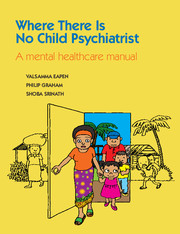265 results

Where There Is No Child Psychiatrist
- A Mental Healthcare Manual
- Coming soon
-
- Expected online publication date:
- April 2024
- Print publication:
- 01 October 2012
-
- Book
- Export citation
The usability and reliability of a smartphone application for monitoring future dementia risk in ageing UK adults
-
- Journal:
- The British Journal of Psychiatry , FirstView
- Published online by Cambridge University Press:
- 15 February 2024, pp. 1-7
-
- Article
-
- You have access
- Open access
- HTML
- Export citation
James Guy Edwards (Guy), FRCPsych, FRCP, DPM, MFPH (Hon.)
-
- Journal:
- BJPsych Bulletin / Volume 47 / Issue 4 / August 2023
- Published online by Cambridge University Press:
- 22 March 2023, pp. 245-246
- Print publication:
- August 2023
-
- Article
-
- You have access
- Open access
- HTML
- Export citation
Clozapine haematological monitoring for neutropenia: a global perspective
-
- Journal:
- Epidemiology and Psychiatric Sciences / Volume 31 / 2022
- Published online by Cambridge University Press:
- 25 November 2022, e83
-
- Article
-
- You have access
- Open access
- HTML
- Export citation
Dora Black, MB, DPM, FRCPsych, FRCPCH (Hon.)
-
- Journal:
- BJPsych Bulletin / Volume 46 / Issue 6 / December 2022
- Published online by Cambridge University Press:
- 06 May 2022, pp. 358-359
- Print publication:
- December 2022
-
- Article
-
- You have access
- Open access
- HTML
- Export citation
Transgender children and young people: how the evidence can point the way forward
-
- Journal:
- BJPsych Bulletin / Volume 47 / Issue 2 / April 2023
- Published online by Cambridge University Press:
- 18 February 2022, pp. 98-104
- Print publication:
- April 2023
-
- Article
-
- You have access
- Open access
- HTML
- Export citation
Michael Llewellyn Rutter, KBE, MD, FRCP, FRCPsych (Hon), FRS
-
- Journal:
- BJPsych Bulletin / Volume 46 / Issue 6 / December 2022
- Published online by Cambridge University Press:
- 23 December 2021, pp. 356-357
- Print publication:
- December 2022
-
- Article
-
- You have access
- Open access
- HTML
- Export citation
9 - Decarbonisation Strategies and Economic Opportunities in Australia
- from Example Economies
-
-
- Book:
- Transitioning to a Prosperous, Resilient and Carbon-Free Economy
- Published online:
- 08 October 2021
- Print publication:
- 28 October 2021, pp 203-236
-
- Chapter
- Export citation
Effects of energy balance on appetite and physiological mediators of appetite during strenuous physical activity: secondary analysis of a randomised crossover trial
-
- Journal:
- British Journal of Nutrition / Volume 126 / Issue 10 / 28 November 2021
- Published online by Cambridge University Press:
- 14 January 2021, pp. 1571-1584
- Print publication:
- 28 November 2021
-
- Article
-
- You have access
- HTML
- Export citation
Donald West, MD, LittD, FRCPsych
-
- Journal:
- BJPsych Bulletin / Volume 45 / Issue 2 / April 2021
- Published online by Cambridge University Press:
- 10 December 2020, pp. 126-127
- Print publication:
- April 2021
-
- Article
-
- You have access
- Open access
- HTML
- Export citation
Infection Prevention and Control Practices Implemented for Congenital Measles in an Extremely Low Birth Weight Infant
-
- Journal:
- Infection Control & Hospital Epidemiology / Volume 41 / Issue S1 / October 2020
- Published online by Cambridge University Press:
- 02 November 2020, pp. s301-s302
- Print publication:
- October 2020
-
- Article
-
- You have access
- Export citation
Acknowledgements
-
- Book:
- So Young, So Sad, So Listen
- Published online:
- 22 June 2020
- Print publication:
- 09 July 2020, pp viii-viii
-
- Chapter
- Export citation
Introduction
-
- Book:
- So Young, So Sad, So Listen
- Published online:
- 22 June 2020
- Print publication:
- 09 July 2020, pp 1-4
-
- Chapter
- Export citation
Foreword to Second Edition
-
- Book:
- So Young, So Sad, So Listen
- Published online:
- 22 June 2020
- Print publication:
- 09 July 2020, pp vii-vii
-
- Chapter
- Export citation
Chapter 3 - What Parents Can Do to Help Build a Child’s Resilience to Depression
-
- Book:
- So Young, So Sad, So Listen
- Published online:
- 22 June 2020
- Print publication:
- 09 July 2020, pp 30-39
-
- Chapter
- Export citation
Chapter 7 - Last Words – from a Parent
-
- Book:
- So Young, So Sad, So Listen
- Published online:
- 22 June 2020
- Print publication:
- 09 July 2020, pp 77-77
-
- Chapter
- Export citation
Contents
-
- Book:
- So Young, So Sad, So Listen
- Published online:
- 22 June 2020
- Print publication:
- 09 July 2020, pp v-vi
-
- Chapter
- Export citation
Chapter 4 - Helping Children Cope with Common Stresses: What Parents Can Do
-
- Book:
- So Young, So Sad, So Listen
- Published online:
- 22 June 2020
- Print publication:
- 09 July 2020, pp 40-53
-
- Chapter
- Export citation
Chapter 5 - When a Child Is Depressed: What Parents Can Do
-
- Book:
- So Young, So Sad, So Listen
- Published online:
- 22 June 2020
- Print publication:
- 09 July 2020, pp 54-63
-
- Chapter
- Export citation
Resources and Further Reading
-
- Book:
- So Young, So Sad, So Listen
- Published online:
- 22 June 2020
- Print publication:
- 09 July 2020, pp 79-81
-
- Chapter
- Export citation



